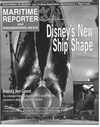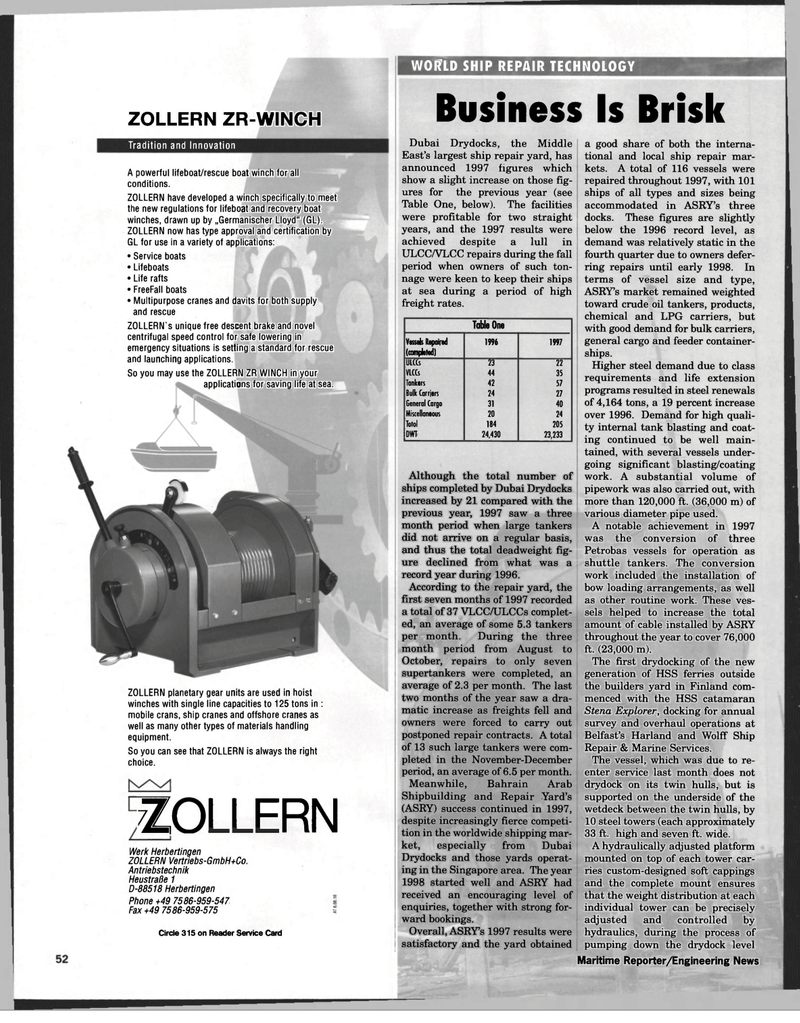
Page 50: of Maritime Reporter Magazine (March 1998)
Read this page in Pdf, Flash or Html5 edition of March 1998 Maritime Reporter Magazine
WORLD SHIP REPAIR TECHNOLOGY
ZOLLERN ZR-WINCH
Tradition and Innovation
A powerful lifeboat/rescue boat winch for all conditions.
ZOLLERN have developed a winch specifically to meet the new regulations for lifeboat and recovery boat winches, drawn up by „Germanischer Lloyd" (GL).
ZOLLERN now has type approval and certification by
GL for use in a variety of applications: • Service boats • Lifeboats • Life rafts • FreeFall boats • Multipurpose cranes and davits for both supply and rescue
ZOLLERN's unique free descent brake and novel centrifugal speed control for safe lowering in emergency situations is setting a standard for rescue and launching applications.
So you may use the ZOLLERN ZR WINCH in your applications for saving life at sea.
ZOLLERN planetary gear units are used in hoist winches with single line capacities to 125 tons in : mobile crans, ship cranes and offshore cranes as well as many other types of materials handling equipment.
So you can see that ZOLLERN is always the right choice.
ZOLLERN
Werk Herbertingen
ZOLLERN Vertriebs-GmbH+Co.
Antriebstechnik
Heustratie 1
D-88518 Herbertingen
Phone +49 7586-959-547
Fax +49 7586-959-575
Circle 315 on Reader Service Card
Business Is Brisk
Dubai Drydocks, the Middle
East's largest ship repair yard, has announced 1997 figures which show a slight increase on those fig- ures for the previous year (see
Table One, below). The facilities were profitable for two straight years, and the 1997 results were achieved despite a lull in
ULCC/VLCC repairs during the fall period when owners of such ton- nage were keen to keep their ships at sea during a period of high freight rates.
Table One
Vessels Repaired 1996 1997 (completed)
ULCCs 23 22
VLCCs 44 35
Tankers 42 57
Bulk Carriers 24 27
General Cargo 31 40
Miscellaneous 20 24
Totol 184 205
DWT 24,430 23,233
Although the total number of ships completed by Dubai Drydocks increased by 21 compared with the previous year, 1997 saw a three month period when large tankers did not arrive on a regular basis, and thus the total deadweight fig- ure declined from what was a record year during 1996.
According to the repair yard, the first seven months of 1997 recorded a total of 37 VLCC/ULCCs complet- ed, an average of some 5.3 tankers per month. During the three month period from August to
October, repairs to only seven supertankers were completed, an average of 2.3 per month. The last two months of the year saw a dra- matic increase as freights fell and owners were forced to carry out postponed repair contracts. A total of 13 such large tankers were com- pleted in the November-December period, an average of 6.5 per month.
Meanwhile, Bahrain Arab
Shipbuilding and Repair Yard's (ASRY) success continued in 1997, despite increasingly fierce competi- tion in the worldwide shipping mar- ket, especially from Dubai
Drydocks and those yards operat- ing in the Singapore area. The year 1998 started well and ASRY had received an encouraging level of enquiries, together with strong for- ward bookings.
Overall, ASRYs 1997 results were satisfactory and the yard obtained a good share of both the interna- tional and local ship repair mar- kets. A total of 116 vessels were repaired throughout 1997, with 101 ships of all types and sizes being accommodated in ASRY's three docks. These figures are slightly below the 1996 record level, as demand was relatively static in the fourth quarter due to owners defer- ring repairs until early 1998. In terms of vessel size and type,
ASRYs market remained weighted toward crude oil tankers, products, chemical and LPG carriers, but with good demand for bulk carriers, general cargo and feeder container- ships.
Higher steel demand due to class requirements and life extension programs resulted in steel renewals of 4,164 tons, a 19 percent increase over 1996. Demand for high quali- ty internal tank blasting and coat- ing continued to be well main- tained, with several vessels under- going significant blasting/coating work. A substantial volume of pipework was also carried out, with more than 120,000 ft. (36,000 m) of various diameter pipe used.
A notable achievement in 1997 was the conversion of three
Petrobas vessels for operation as shuttle tankers. The conversion work included the installation of bow loading arrangements, as well as other routine work. These ves- sels helped to increase the total amount of cable installed by ASRY throughout the year to cover 76,000 ft. (23,000 m).
The first drydocking of the new generation of HSS ferries outside the builders yard in Finland com- menced with the HSS catamaran
Stena Explorer, docking for annual survey and overhaul operations at
Belfast's Harland and Wolff Ship
Repair & Marine Services.
The vessel, which was due to re- enter service last month does not drydock on its twin hulls, but is supported on the underside of the wetdeck between the twin hulls, by 10 steel towers (each approximately 33 ft. high and seven ft. wide.
A hydraulically adjusted platform mounted on top of each tower car- ries custom-designed soft cappings and the complete mount ensures that the weight distribution at each individual tower can be precisely adjusted and controlled by hydraulics, during the process of pumping down the drydock level 78B Maritime Reporter/Engineering News

 49
49

 51
51
